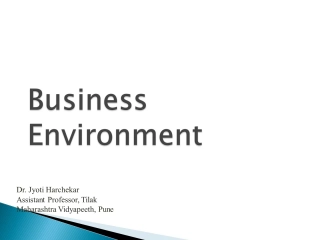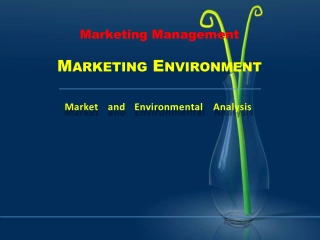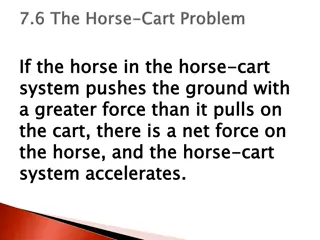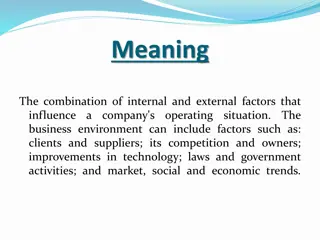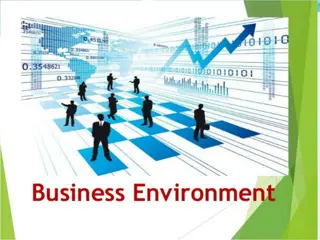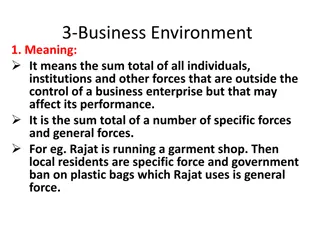
PESTLE Framework for Business Success
Explore the PESTLE framework, which identifies six external influences on businesses: Political, Economic, Social, Technological, Environmental, and Legal factors. Learn how these factors affect day-to-day operations, decision-making, and strategies of businesses, with examples such as government support, economic policies, social attitudes, technological advancements, environmental concerns, and legal regulations.
Download Presentation

Please find below an Image/Link to download the presentation.
The content on the website is provided AS IS for your information and personal use only. It may not be sold, licensed, or shared on other websites without obtaining consent from the author. If you encounter any issues during the download, it is possible that the publisher has removed the file from their server.
You are allowed to download the files provided on this website for personal or commercial use, subject to the condition that they are used lawfully. All files are the property of their respective owners.
The content on the website is provided AS IS for your information and personal use only. It may not be sold, licensed, or shared on other websites without obtaining consent from the author.
E N D
Presentation Transcript
C1 EXTERNAL ENVIRONMENT PESTLE identifies 6 external influences on business. Can you work out what PESTLE stands for? P _ _ _ _ _ _ _ _ E _ _ _ _ _ _ _ S _ _ _ _ _ T _ _ _ _ _ _ _ _ _ _ _ _ L _ _ _ _ E _ _ _ _ _ _ _ _ _ _ _ EXTERNAL ENVIRONMENT
EXTERNAL ENVIRONMENT In this topic you will learn about Political, e.g. government support, membership of trading communities such as the European Union Statutes and regulations current at the time should be used. Economic, fiscal, monetary and other government policies e.g. supply side policy, economic growth, exchange rates Social attitudes to saving, spending and debt; social responsibility requirements; change e.g. to demographic trends, consumers tastes/preferences Technological change, e.g. Automation; improved communications Environmental factors and ethical trends, e.g. carbon emissions, waste, recycling, pollution Legal environment, e.g. Partnership Act 1890, Companies Act 2006, Charities Act 2011, Competition Act 1998, UK Corporate Governance Code, financial services regulation, industry regulators, government departments
PESTLE The external environment is all of those factors outside of the control of a business that will impact on its day to day operations, decision making and strategies This creates opportunities e.g. technological advancements and threats e.g. rising interest rates The impact of Brexit on the UK. One major change has been the vote in June 2016 for the UK to leave the EU This is a big topic so you will have to be selective in identify those aspects that have the biggest influence on your chosen businesses.
POLITICALENVIRONMENT The political environment is the government actions that impact on the strategic and functional decisions made by businesses These actions can be by local, national or international authorities How the UK Government works. They will impact heavily on the competitive environment and the infrastructure that allows businesses to operate effectively
POLITICALENVIRONMENT - GOVERNMENTSUPPORT The government can provide grants to businesses for specific purposes e.g. relocation Can be from Local, National or European Government The government can provide training to start up businesses in a variety of areas: Why does the Government support SMEs? Financial e.g. small business accounts Marketing e.g. how to target market segments Operations management e.g. advice on location People e.g. how to recruit a suitable workforce
POLITICALENVIRONMENT - ENTERPRISE Entrepreneurs and SMEs impact on businesses in a number of ways: Create competition Why do you think that the Government has a target to spend 25% of its budget with SMEs? Supply goods and services Offer specialisms and expertise Buy goods and services Entrepreneurs and SMEs impact on the economy in a number of ways: Provide employment Welsh politicians argue that SMEs are the lifeblood of the welsh economy. How important are SMEs in your area? Pay taxes Social benefits
POLITICALENVIRONMENT - GOVERNMENTSUPPORT Preparing for assessment: Are there any regulations that apply specifically to the actions of your businesses? Regulation is undertaken by government to create competitive markets The government believes that this will protect the interests of consumers so that they are not exploited by businesses Effective regulation will lead to greater choice and lower prices Regulation takes place in a number of industries such as telecoms, water and energy A key reason for regulation is to create conditions for continued investment in infrastructure in important areas of the economy
POLITICALENVIRONMENT - GOVERNMENTSUPPORT De-regulation is the opening up of markets to new competition through the removal of rules and regulations that created barriers to entry Arguments for de-regulation include: The creation of competitive markets will lead to greater efficiency Businesses strive to reduce costs in order to compete effectively Businesses strive to meet consumer demand by reducing price and providing a greater range of products Less government intervention allows firms to produce to the needs of the market
POLITICALENVIRONMENT - GOVERNMENTSUPPORT Governments will look to improve the infrastructure to help businesses operate more effectively. This will include the: Crossrail. Transport network Improves ease and speed of connections e.g. rail, road and air Provision of utilities Ensuring electricity, gas, water etc. are adequately supplied Provision of information Ensuring access to fast information e.g. broadband
TRADINGCOMMUNITIES Trading communities can also be network groups for specific industries. These might share knowledge and expertise. Trading blocs are when the governments of a group of countries agree to trade together freely i.e. normally with no trade barriers The countries are normally grouped together geographically e.g. the European Union (EU) The members of a trading bloc make preferential economic, and sometimes political, arrangements to boost trade within the member states Trading blocs in numbers.
THE EUROPEAN UNION The Single market has 27 member states and is a major world trading power. As an economic force, it is larger than the USA. The UK voted to leave in 2016. Advantages Disadvantages Trade creation Trade is encouraged within member states because there are no barriers, so additional trade is created within the bloc. Trade diversion The existence of the common external tariff, diverts trade away from the EU. Goods within the SEM may be more expensive, and this could damage consumer welfare. Competition Stronger competitive forces within the SEM can drive productive and dynamic efficiency, which will benefit consumers. Monopolies In some markets e.g. gas and electricity, tariffs have seen significant merger activity and the creation of large monopolies seeking to exploit the available economies of scale. Access to markets The SEM creates a market of 28 countries and a population of over 500m, offering significant scope for businesses to expand. Unemployment In some countries, workers may lose their jobs as production is transferred to member states with lower labour costs. Freedom of movement There is the right to live and work anywhere within the SEM without restriction which boosts labour mobility. Cost Membership of the SEM costs the UK around 15b per year.
EU ENLARGEMENT Since its inception in 1958, the EU has grown from 6 to 28 member states, with Croatia the most recent country to join in 2013 In 2016 the UK voted to leave the EU At the current time there are a further 5 candidate countries for EU membership i.e. Iceland, Macedonia, Montenegro, Serbia and Turkey Potential positive implications of enlargement include: EU enlargement has increased the potential for economies of scale and free trade across a larger geographical area and population For consumers, the increased competition may drive down production costs leading to lower prices and increased choice and quality For businesses, they will be able to take advantage of the relative low wages of new accession countries However, there are some potential negatives to EU enlargement, which include: Can the UK cope with the influx of migrant workers from new accession countries? New countries may require additional support from the EU, which may be partly funded by stronger nations EU enlargement may increase bureaucratic costs for all existing members In 2013 the EU restarted talks with Turkey after 3 years.
IMPACTONBUSINESSESOFTRADING COMMUNITIES Does this impact on your chosen businesses? There are a large number of potential impacts, both positive and negative. Some of these include: Free trade within the bloc encouraging specialisation and trade Consider: Do they buy or sell within Europe? Easier access to knowledge, workers and components Is there competition from businesses in Europe? Economies of scale Take advantage of favourable differences between members e.g. taxes or labour costs Has EU membership affected the workforce? May reduce trade with countries outside of the bloc Not all members may have same power Will they be affected by the BREXIT vote? May damage domestic industries
ECONOMICENVIRONMENT The economic environment consists of the key economic factors that influence the behaviour of businesses and their customers What is the current state of the UK economy? The business cycle shows fluctuations in the level of economic activities How does this affect consumer spending? How does this affect demand for your chosen businesses? Economic activity is measured by GDP (Gross Domestic Product) GDP is the total value of a country s output in a year Consider whether your businesses sell luxury goods or necessities. These fluctuations affect both business and consumer confidence as well as ability and willingness to spend When money is tight do people still give to charity?
INFLATION A general rise in prices or a fall in the value of money The rate of inflation shows how prices have changed based on the same period a year earlier What is the current rate of inflation in the UK? It is an indication of the cost of living changing How will your businesses be affected? Costs Profits Consumer spending
INFLATION The effect on businesses The Government have set an inflation target of 2%. The Bank of England s Monetary Policy Committee (MPC) meet once a month to decide the Bank s Rate of Interest. If CPI is too high they might raise interest rates to reduce the rate of inflation. Increased costs due to higher inflation can be passed onto the consumer if they would be willing to pay higher prices if not the firm will have to try and absorb the increased costs through lower profit margins this has an impact on the pricing strategy of a firm some firms will reduce the supply of the product it becomes increasingly difficult to maintain competitiveness demand will fall if the firm has to raise price if a firm exports then it will see customers move to companies abroad where prices are not rising as fast Highlight which of these bullet points relate to your business. Can you explain why?
EXCHANGERATES The price of one currency in terms of another e.g. 1 = $1.50 An increase in the value of a currency is called an appreciation this means the currency is worth more e.g. 1 = $1.60 A decrease in the value of a currency is called a depreciation this means the currency is worth less e.g. 1 = $1.40 If a pair of trainers costs 50 in the UK and are exported to USA how much are they in USA assuming the exchange rates is 1: $1.50? 1 = $1.50 50 x 1.50 = $75 What happens if the exchange rate appreciates to $1.60 or depreciates to dollar $1.40?
EXCHANGERATES The effect on businesses: SPICED (strong pound: imports cheaper, exports dearer) Firms that import will be able to buy cheaper raw materials and finished goods Firms that export will see less demand Do your businesses import or export? Do they sell to tourists? Is the current exchange rate strong or weak? WPIDEC (weak pound: imports dearer, exports cheaper) There will be greater demand from abroad for UK goods Input prices will increase if raw materials are imported If the firm has a price inelastic product it will be able to pass the increase in costs onto the consumer Does this have a major impact on your businesses or not? Fluctuations in exchange rates create uncertainties Prices will change regularly if a firm trades with foreign businesses This will impact on the competitiveness of businesses, with costs and revenues increasing or decreasing and the profitability of the business being affected favourably or adversely
INTERESTRATES The effect on business: If a firm has loans or overdrafts this will effect the amount that has to be paid in interest which is a cost to a business Investments either become more or less attractive influencing the ability of firms to grow by investing in new capital equipment or larger premises Influences the level of demand by consumers If interest rates are high saving is more attractive and spending less attractive Interest rates will affect customers willingness to spend on credit High interest rates will mean that consumers have less disposable income e.g. higher mortgage payments and therefore a fall in demand for other products Higher interest rates mean that foreign investors will invest in UK banks for higher returns and therefore an increase in demand for the will see its value appreciate making exports dearer The price of money i.e. the cost of borrowing or the reward for saving. Interest rates explained.
TAXATION Taxation is the process of imposing charges on business and individuals by the government For example: Businesses are charged corporation tax on profits Consumers are charged VAT on goods and services bought as well as income tax on earnings The effect on business: A cut in income tax may give consumers more disposable income, thus raising consumption However if income tax is raised this may discourage spending and reduce consumption A cut in corporation tax may increase available profits for firms which may stimulate investment Changes to VAT will affect the price to consumers and also the costs to a business In 2011 VAT was put back up to 20%. How would this have impacted on your businesses?
GOVERNMENTSPENDING The expenditure by the government on supplying goods and services to achieve economic and political objectives The effect on business: Budgets allocated to public sector organisations e.g. NHS, schools and armed forces will affect demand for suppliers to these organisations Spending on infrastructure e.g. road repairs will generate employment increasing incomes and therefore general levels of demand Benefits paid will affect levels of disposable income amongst recipients Pay rates to public sector workers will affect levels of disposable income amongst recipients
BUSINESSCYCLE Split the group into 4 teams. Each team to take a different stage in the business cycle. Using your knowledge of economic influences explain how businesses will be affected by the stage where the economy is in the business cycle.
ECONOMICENVIRONMENT The economic influences are affected by government policy: Fiscal policy is the manipulation of government spending, taxation and government borrowing to influence the level of economic activity Monetary policy is the manipulation of the rate of interest, the money supply and exchange rates to influence the level of economic activity Supply-side policy is the actions taken by the government to increase the productive capacity of the economy e.g. training and lower income tax
SOCIALENVIRONMENT The social environment is influenced by the make up of humans within a specific area or business What are the trends in the UK population? This influences the behaviour of businesses and customers Social change can occur as a result of demographic change Demographics is the statistical study of human populations e.g. the make up of society How would you summarise the UK population and trends in just 10 bullet points? Demographics can include: Gender Age Ethnic background Education
SOCIALENVIRONMENT Urbanisation Migration A general movement of people towards cities and away from rural areas The movement of people between countries Net migration = relationship between migration and immigration This has occurred as people move towards jobs and is being seen on a global basis London responds to urbanisation by becoming smart. Increases the supply of labour as more people come into a country seeking employment It puts pressure on infrastructure with increased traffic congestion, demand for housing and other services such as education and health Often willing to work for the minimum wage Cities have responded by redesigning housing and traffic systems e.g. encouraging more use of cycling and public transport The EU offers free movement of labour between member states Population growth.
SOCIALENVIRONMENT The impact of demographic changes. How a business might respond: An increase in the global population size an opportunity for UK businesses to move into new markets with new or existing products An increase in the average age of UK society businesses will have to change their product range to satisfy the needs of older people Falling EU birth rates as EU market size falls but the population gets richer UK businesses might move into premium product markets
OTHERSOCIALFACTORS Changing consumer tastes Wider range of experiences as a result of living in a more culturally diverse country Greater access to information affecting attitudes to ingredients in foods More informed decisions leading to more consumers following diets that are vegetarian, vegan, gluten free etc. Changing consumer tastes hurt McDonald s and Coca-Cola. Lifestyles Health care has also been transformed with people living longer and healthier lives Health and fitness and healthy eating have led to increased demand for related businesses such as gyms and health foods This has led to a whole industry developing around health Extending life. This has allowed for highly differentiated niche markets with specialist businesses developing new products e.g. protein products for bodybuilding or accessories for cyclists Other lifestyle changes such as smaller families, more couples not having children, single parent families, working mothers etc all affect the types of products that are demanded
SOCIALENVIRONMENT Social attitudes to saving, spending and debt What are your attitudes? What factors have influenced Britons changing attitude to saving? If you were given 10 what would you do with it? What about if it was 5 000? How will this impact on your businesses? Are you willing to wait to buy what you want or would you go into debt to have it now? Are your attitudes the same as your parents generation? What about your grandparents generation?
TECHNOLOGICALCHANGE Technological change describes the ongoing development of invention, innovation and sharing of technology or processes. It is the diffusion or spreading of technological change through society that impacts upon business behaviour Banks turning to voice recognition. Technological changes include: Intranet and internet Social media CAD/CAM and robotics Handheld computers Software packages e.g. DTP, spreadsheets and databases Online businesses Integrated software packages Big data and data mining
AUTOMATION Automation The use of machines to control a process e.g. stock control, production line, warehousing and distribution Stock control More accurate predictions of stock usage through statistical analysis Automatic control of stock levels and reordering Assess data on stock levels and geographical location Retailers use EPOS (Electronic Point of Sale) technology barcodes scanners databases Inside a robot-run warehouse.
COMMUNICATION Internal Interdepartmental Operations management could e- mail HR about staffing requirements Managing supplier relationships, if for example stock is not delivered it may be because of the business being over their credit limit Order processing Waiters use hand held devices to transfer orders to the kitchen Quality data Telling production workers about the number of defects External Working with suppliers Using EDI (Electronic Data Interchange) to process orders Automatic reordering from a stock control system Sourcing supplies Growth of the internet to find new suppliers Tracking of supply chain Informs customers of the progress of their order CEO Secrets: Reddit boss shares three tips for success.
TECHNOLOGICALCHANGE Technology is impacting heavily with social media and developments in technological products transforming lives This has created big data for businesses, allowing them to analyse the buying habits of consumers Businesses have adapted their marketing to reflect changes in consumer lifestyle and buying behaviour. This includes: Viral marketing Use of social media to encourage the spread of promotional activities and increase brand awareness Use of blogs and online forums Social media The use of virtual communities to communicate with actual and potential customers Emotional branding Building a brand that will directly tap in to the consumers feelings, personal psychological needs and aspirations e.g. presents a feeling of belonging or success A brand sells a status or a life style choice How many of you own an iPhone? Why?
TECHNOLOGICALCHANGE E-commerce involves digitally enabled commercial transactions between and among organisations and individuals What is e- commerce? This has been a key area of growth for a number of businesses such as those in the supermarket industry, Spotify and Apple in the streaming music industry, Uber in the taxi industry and Amazon Online access has transformed a range of markets, helping to cut costs and provide an enormous range of products Amazon. It has also empowered consumers, providing information symmetry and greater buying power as consumers can shop around
ENVIRONMENTALFACTORS Environmental costs of business activity include: Air, water and noise pollution Contamination making the environment unsafe or unsuitable Climate change A change in global weather patterns over a prolonged period of time A result of carbon dioxide emissions into the environment Congestion Blockages in traffic flow as a result of overcrowding Destruction of the environment Long term damage done to the natural environment e.g. deforestation Waste disposal The ways in which businesses discard unwanted materials generated from business activity Divide the class into 5 groups. Each group should take one of these environmental costs and prepare a short presentation to give more detail on how businesses damage the environment.
ENVIRONMENTALFACTORS Legislation designed to influence the behaviour of individuals and businesses in order to reduce the negative impacts on the natural environment Limits to emission levels to sea, rivers and air Guidelines, limits and bans on waste disposal Quotas on use of finite resources e.g. fishing quotas Plastic bags: Should the Government have intervened? Government can inspect businesses and impose fines on those failing to comply Compliance can often increase costs to a business
ENVIRONMENTALFACTORS These laws help to ensure that businesses do not have a negative impact on the environment Environmental Protection Act Businesses must improve the control of pollution arising from industrial and other processes Environment Act A business must clean up any contaminated sites that it owns The Act also established the Environment Agency in order to oversee environmental protection
HOWBUSINESSESRESPOND How businesses can respond to environmental factors: New environmentally friendly production New products that meet higher environmental standards Greater use of recycling Green audits, objectives and policies Innovative processes to reduce environmental harm Less packaging Local sourcing Is it possible to make a profit whilst making a difference? Have your businesses taken actions to reduce the negative impact they have on the environment? Summarise the actions taken. Why is this also good marketing?
ENVIRONMENTALLYFRIENDLYPOLICIES Positive media/public relations Brand loyalty Unique selling point Employee engagement Avoid fines and negative PR May cost more in the short term but lead to cost savings in the long term
ETHICS Business ethics looks at morality in decision-making This infers doing what is right Peoples views can differ on what is right or wrong Ethics in strategic decisions include: Location decisions Ability to exploit workers Impact on the environment Mergers, takeovers and retrenchment Impact on workers Ability to exploit customers or control suppliers Transparency of deals Corruption Dealing with authorities Power over suppliers or customers Working with suppliers Ethical sourcing e.g. Fairtrade Fair payment terms Does ethics relate to tactical decisions e.g. advertising?
ETHICALFACTORS Environmental Responsibility to the planet Air, water and noise pollution Longer term impact s e.g. global warming, non-renewable resources Animal rights Not testing on animals The waste mountain of coffee cups. Animal welfare e.g. free range chickens
ETHICALFACTORS Treatment of workers, suppliers and customers Workers Non-discriminatory treatment Pay and working conditions Workplace bullying Fair references Truthful information Suppliers Payments on time Honour contracts Not bullying small suppliers Customers Fair pricing, non exploitative Truthful information Supply chain transparency Honest advertising
LEGALENVIRONMENT Legislation involves creating and enacting laws in order to protect individuals, businesses and society as a whole The legal environment describes the collection of legislation that impact on the activities of organisations Laws are passed through UK Acts of Parliament The UK is subject to EU laws but this is likely to gradually change after leaving the European Union Should Sunday trading hours be dictated by the Law?
LEGALENVIRONMENT Competition law looks to promote fair competition in markets and stop the abuse of consumers by businesses due to monopoly power. This means that anticompetitive practices such as price fixing between businesses are illegal. Mergers and takeovers are monitored and will not be allowed if it is deemed that they significantly reduce competition. Top model agencies accused of price fixing by watchdog. Markets that are not competitive will be investigated with a view to increasing competition. Firms are not allowed: to agree prices with competitors to limit production in order to reduce competition partition markets or customers between each other e.g. geographically where each firm takes a different region to avoid competition Despite the UK voting to leave the EU in June 2016 it is likely that we will still have to abide by a majority of these laws in order to carry on trading with EU countries.
LEGALENVIRONMENT Areas of legislation affecting businesses include: Ability of businesses to issue free carrier bags Display of cigarettes Living wage Should there be a sugar tax and ban on offers? Trading hours Labelling and packaging Advertising
LEGALENVIRONMENTRESEARCHACTIVITY Are your chosen businesses either a partnership, a charity or a company? As appropriate research: Partnership Act Company Act Charities Act What industries are your businesses in? Are there any regulators? Identify at least one other area of legislation that affects your businesses
EXTERNAL ENVIRONMENT In this topic you have learnt about Political, e.g. government support, membership of trading communities such as the European Union Economic, fiscal, monetary and other government policies e.g. supply side policy, economic growth, exchange rates Social attitudes to saving, spending and debt; social responsibility requirements; change e.g. to demographic trends, consumers tastes/preferences Technological change, e.g. Automation; improved communications Environmental factors and ethical trends, e.g. carbon emissions, waste, recycling, pollution Legal environment, e.g. Partnership Act 1890, Companies Act 2006, Charities Act 2011, Competition Act 1998, UK Corporate Governance Code, financial services regulation, industry regulators, government departments

